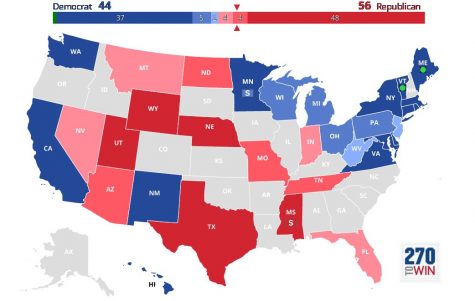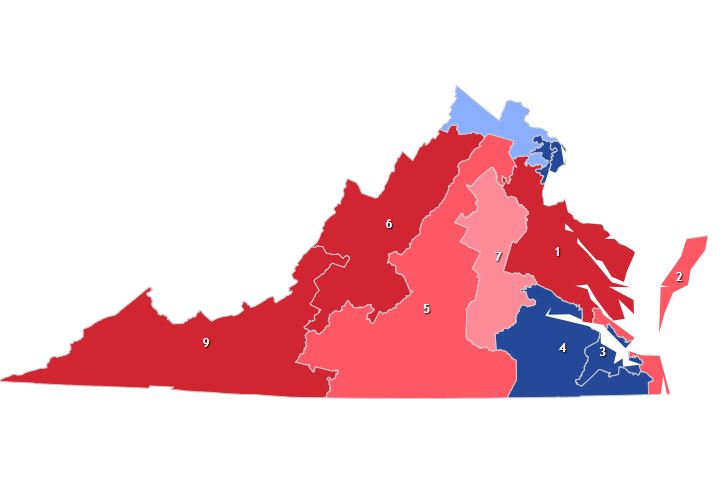Connor’s Predictions
November 6, 2018
Connor’s Predictions for U.S. Senate races:

Solidly Democratic: California, Washington, Minnesota 1, New Mexico, Virginia, New York, Vermont*, Maine*, Massachusetts, Rhode Island, Connecticut, Maryland, Delaware
*The senators from Vermont and Maine are independents who caucus with the Democratic Party
Likely Democratic: Michigan, Ohio, Pennsylvania, Minnesota 2, Wisconsin
Leaning Democratic: West Virginia, New Jersey
Leaning Republican: Nevada, Indiana, Florida, Montana
Likely Republican: Arizona, Tennessee, North Dakota, Missouri
Solidly Republican: Utah, Wyoming, Nebraska, Mississippi 1, Mississippi 2, Texas
[Mississippi and Minnesota both have two Senate races due to Senator Thad Cochran of Mississippi retiring because of his health conditions and Senator Al Franken (D-MN) resigning due to sexual assault allegations.]
The solidly Democratic races or the darkest shade of blue on the map are races that will most likely have a Democratic win. In my opinion, in these races, there is virtually no chance of a Republican winning.
The Virginia Senate race is between incumbent Senator Tim Kaine (D-VA) and Corey Stewart (R-VA). Senator Kaine has a long history of being in Virginia politics. He has served as the mayor of Richmond, lieutenant governor, and governor of Virginia. He was also Hillary Clinton’s running mate in 2016. Stewart is the current chairman of the Prince William County Board of Supervisors. In every statewide election, Senator Kaine has received over 50% of the vote. For Stewart, this will be a very challenging race to win.
The likely Democratic races are those that are the next shade lighter. Ohio, Michigan, Pennsylvania, and Wisconsin are all states that President Trump won in 2016, but they have strong incumbent senators.
In addition to the regular Senate race, Minnesota will have a special election to fill the seat of former Senator Al Franken (D-MN), who resigned because of sexual assault allegations. The Governor of Minnesota appointed Tina Smith (D-MN) to fill that position, which she will now defend in November’s election. Recently, Smith did not show up to debate her Republican opponent, Karin Housley. This is a very bad look for Senator Smith, and will hurt her in the election. Minnesota is generally seen as a blue state, but President Trump only lost the state by 40,000 votes in 2016.
The leaning Democratic races have very differing landscapes from each other. The incumbent in West Virginia is Senator Joe Manchin (D-WV), who has shown that he is able to work with President Trump, such as voting to confirm Justice Kavanaugh. President Trump won West Virginia with 67.9% of the votes in 2016. Hillary Clinton only received 26.2% of the votes there. This election is an uphill battle for Manchin, but I think that he will be able to pull through because he has great name recognition in the state, and he is very popular.
The New Jersey Senate race is between incumbent Senator Robert Menendez (D-NJ) and Republican businessman Bob Hugin. Menendez faced trial for allegations regarding bribery and corruption. CNN has a great article explaining the charges. The trial resulted in a mistrial, but the Senate Ethics Committee “severely admonished” Menendez. This has tarnished his reputation, with a recent Rutgers University poll showing him with only a 5% lead. Hillary Clinton won New Jersey by 14%. This is a major red flag for Democrats who wish to take control of the Senate.
The leaning Republican states are Nevada, Indiana, Florida, and Montana. On the map, they are the lightest shade of red. Nevada is the only state out of the four that has a Republican incumbent. Hillary Clinton won Nevada in 2016 with 47.9% of the vote, but Senator Dean Heller (R-NV) won his state in 2012 with 45.9% of the vote. Senator Heller has had President Trump and Vice President Pence visit his state to rally supporters, and I believe his popular standing in the state and becoming much more closer to Trump will equal him a win in November.
The Indiana Senate seat is held by incumbent Senator Joe Donnelly (D-IN). The Republican challenger to Senator Donnelly is businessman Mike Braun. This is the home state of Vice President Pence and a frequent rally stop of President Trump, so I am positive that Republicans have a great chance of retaking this seat.
Florida is a very interesting race to look at this year. It is a match up between Governor Rick Scott (R-FL) and incumbent Senator Bill Nelson (D-FL). These politicians have been household names in Florida for decades. Senator Nelson (D-FL) began his political career as a United States Congressman in 1979 and then won election to the United States Senate in 2001. Governor Scott (R-FL) has been the Governor of Florida since 2011, and was the CEO of Columbia Hospital Corporation, which became the largest private for-profit healthcare company in the United States. According to Vox.com, Governor Scott (R-FL) has outspent Senator Nelson’s campaign by a 4 to 1 margin. Governor Scott has been a very popular governor, especially handling hurricane disasters very well. This race is difficult to call, but I think Scott will be able to pull it off.
The Montana seat is leaning Republican because incumbent Senator Jon Tester (D-MT) won this seat in 2012, while Republican presidential candidate Mitt Romney (R-MA) won the state with 55.3% of the vote. This could be alarming to Republicans, but President Trump won this state with 55.6% of the vote. Also, the Republican challenger, who is the auditor of the state of Montana, was elected statewide in 2016 with 53.6% of the vote. President Trump has made Montana a frequent rally location because it is very possible that Republicans can win this seat in November.
The likely Republican states are Arizona, Tennessee, North Dakota, and Missouri. On the map, they are the next shade darker. Two of the states are held by Republicans (Arizona and Tennessee), while two are held by Democrats (North Dakota and Missouri).
The Arizona seat is open due to incumbent Senator Jeff Flake (R-AZ) not running for re-election. Republican congresswoman Martha McSally (R-AZ) and congresswoman Kyrsten Sinema (D-AZ) are running to replace Senator Flake. Historically, Arizona is a Republican state and I believe that it will remain that way. Congresswoman Sinema (D-AZ) has come under fire recently because of videos that have surfaced of her saying to a Texas crowd “Stop your state from becoming like Arizona,” in another video, she refers to Arizona as a “Meth lab of democracy,” in another video, she compares her state to Lindsay Lohan, “We’re not famous in a good way, we’re famous in a Lindsay Lohan kind of way.” These remarks have led the Arizona State Troopers Association to withdraw their endorsement of Sinema. Is this really the person the people of Arizona would like to elect as Senator? These videos seem to have killed her campaign in the state, and it would take a miracle to revive it.
At the beginning of this election cycle, many thought that the state of Tennessee could be a pick-up for the Democratic Party. Incumbent Senator Bob Corker (R-TN) chose not to run for re-election. The Election is between Congresswoman Marsha Blackburn (R-TN) who has been representing the 7th District of Tennessee since 2003 and former Governor Phil Bredesen (D-TN) who was governor from 2003 to 2011. This race was shoved into national spotlight when celebrity artist Taylor Swift announced on Instagram that she will be voting for Bredesen, “As much as I have in the past and would like to continue voting for women in office, I cannot support Marsha Blackburn. Her voting record in Congress appalls and terrifies me,” Swift says. A poll conducted by the New York Times after Swift’s endorsement of Bredesen has Blackburn up by 14%. Polls can not be seen as 100% accurate, but this is a clear sign that it will not have a major effect on the race. Those living in middle America do not like being told what to do by Hollywood and celebrities, and the action could possibly hurt Bredesen’s chances.
North Dakota is a state that the Democratic party thought that they could hold onto. This Senate seat is held by Senator Heidi Heitkamp (D-ND) and is being challenged by Congressman Kevin Cramer (R-ND). Senator Heitkamp recently voted “no” on the Kavanaugh confirmation vote, which cemented her future. President Trump won North Dakota with 63% of the vote. The voters of North Dakota expected their senator to vote for the judicial nominations of President Trump. Senator Heitkamp has not fulfilled this expectation, which is proven with a recent poll conducted by Gray Television, which has Cramer (R-ND) leading by 16%. Also, Congressman Cramer has won statewide election 3 times because North Dakota is only given 1 representative in Congress. He won in 2012 (55% of vote), 2014 (55% of the vote), and 2016 (69% of the vote). This proves that he is capable of winning statewide and replacing Senator Heitkamp.
Missouri’s incumbent Senator Claire McCaskill (D-MO) is in a similar position as Senator Heitkamp (D-ND). Senator McCaskill is being challenged by the Attorney General of Missouri Josh Hawley (R-MO). In a recent undercover video released by Project Veritas, where a regional director for her campaign explains that she does not reveal her true position on gun control and that she could possibly vote to impeach President Trump even if she runs on telling voters that she will not. This is a major concern for Republicans and independents who had thought about voting for McCaskill over Hawley. What they would have voted for is not what they would have got. Senator McCaskill has won statewide in Missouri twice, in 2006 (49% of the vote) and 2012 (54% of the vote). Attorney General Hawley won statewide in 2016 with 59% of the vote, which proves he is able to win with a larger margin statewide than McCaskill.
The solidly Republican states are Utah, Wyoming, Nebraska, Mississippi 1, Mississippi 2, and Texas. On the map, they are the darkest shade of red. These races that will most likely have a Republican win. In my opinion, in these races, there is virtually no chance of a Democrat winning.
The most interesting race out of the solidly Republican states is Texas. The incumbent is Senator Ted Cruz (R-TX). He is well-known across the country because of his presidential campaign in 2016 and the final opponent of President Trump during the Republican primary. The Democratic party nominated Robert O’Rourke to take on Cruz. O’Rourke (D-TX) is the current congressman for the 16th district of Texas. According to the Center of Responsive Politics, O’Rourke has received over 60 million dollars from direct contributions, while Cruz has received over 35 million dollars from direct contributions. Senator Cruz will win re-election because of several factors. The governor of Texas, Greg Abbott (R-TX), is extremely popular and will cruise to re-election, thereby helping Cruz get more Republican voters to the polls. Also, President Trump recently held a rally for Cruz in Houston, Texas, where over 100,000 people requested tickets to attend. Historically, Texas is a red state that will not shift blue anytime soon.
Connor’s House Predictions:
Solidly Democratic: 3rd, 4th, 8th, 11th
Leaning Democratic: 10th
Leaning Republican: 7th
Likely Republican: 2nd, 5th
Solidly Republican: 1st, 6th, 9th
Like the solidly Democratic states for U.S. Senate, these districts will most likely have a Democrat win. These districts are located in Northern Virginia, Richmond suburbs, and the Hampton Roads region.
The leaning Democratic district is the 10th district seat held by Congresswoman Comstock (R-VA). Hillary Clinton won this district in 2016 with 52% of the vote, while Comstock won with 53% of the vote. This means there were a lot of cross-party voters, but the Democratic party is very energized, especially in this district which is located in the Washington D.C. suburbs. Both candidates have spent millions on this race, making it the most expense race in Virginia this year. Comstock has proven that she has the capability of winning in tough election years, but I am not sure if she will succeed this year.
The leaning Republican district is the 7th, which is currently held by Congressman Brat (R-VA). Congressman Brat won this seat in 2014 (60% of the vote) and in 2016 (58% of the vote). Brat has proven that he is a strong candidate in this district. I am not sure why the Democrat Party believes that they have a strong chance of winning, but according to the Virginia Public Access Project, his opponent, Abigail Spanberger, has spent close to 6 million dollars. I think Congressman Brat will survive this election, but it will be a lower margin than he typically wins by.
The likely Republican districts will most likely have a republican win. There is nothing notable to report in the 2nd and 5th districts.
The solidly Republican districts have a very high chance of a republican win. This includes the district that contains Stafford County, which is held by Congressman Rob Wittman (R-VA). Congressman Wittman has been the representative of this district since 2007. He is very well-known in this conservative-leaning district and his opponent, Vanige Williams is lesser known. President Trump won this district with 53% of the vote in 2016, while Wittman won it with 60% of the vote. This proves that Wittman is able to win support from independents and democrats.
The other districts that are solidly Republican are the 6th and 9th. President Trump won the 6th district with over 60% of the vote and he won the 9th district with close to 70% of the vote. There is really no chance that a Democrat could win in those atmospheres.


